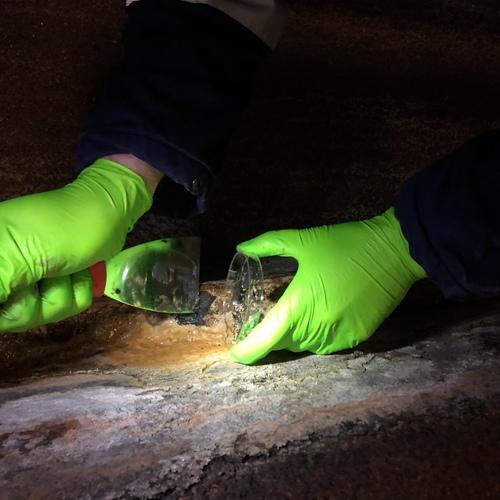During an inspection in an underground car park an inspector of Nebest B.V. discovered a rather dramatic looking, slimy, yellow and green deposit on a steel sheet pile wall. Furthermore, measurements at various places showed more corrosion damage than expected. Since biological corrosion, or MIC corrosion, was suspected, Nebest decided it was time to call in an MIC corrosion expert from Microbial Analysis. Microbial corrosion is feared because it can make material disappear in a relatively short period of time.
For our research, we collected a number of samples of the corrosion products from the damaged sheet piling. Water samples were also taken near these sites. Our examination of the water samples showed that all nutrients for growth of MIC-related micro-organisms were present. Relatively high numbers of MIC-related microorganisms were detected in all samples. At one location, where the sheet piling was in constant contact with water, pitting corrosion characteristic for MIC corrosion was clearly identified. For the remaining damage, the chemical analysis of the corrosion products showed that microbial corrosion was most likely not the primary cause.

The relatively high number of MIC-related microorganisms in the samples is not unexpected in a humid environment such as an underground car park. Nevertheless, based on the analysis results, MIC corrosion does not seem to be the main cause of most of the damage. However, given the conditions in the parking garage, an increased risk for MIC corrosion should be considered in the future in those locations where water continuously comes into contact with the metal. This creates oxygen-poor conditions, which are ideal for the occurrence of MIC corrosion. An additional problem in this parking garage is that the water, which flows along the walls in some places, contains high concentrations of salts. This increases the chance of chemical/atmospheric corrosion.
The steel sheet piles in the multi-storey car park function as soil and water retaining walls and are installed up to approximately 18 m below sea level. Behind the sheet piling is a cement bentonite wall up to about 32 m below NAP. On the inside of the parking garage, water regularly flows along the sheet piling in some places.
To properly map the situation Nebest performed ultrasonic wall thickness measurements at various positions on the sheet piling. Based on these, strength calculations were performed and an estimate was made of the remaining lifetime of the sheet piling. This showed that the corrosion rate was higher than one would expect based on normal atmospheric corrosion. The unusual slimy, yellow and green deposits that were found are also not typical for normal corrosion.
Even though the bacteria are not the main cause of the corrosion problems in the parking garage, the conditions do increase the risk of biological corrosion. Our advice was therefore to regularly perform MIC measurements at more locations and to include this as part of an integral corrosion inspection. A timely diagnosis of MIC corrosion can prevent much damage and the associated costs. In addition, we advised to take measures to prevent contact between the sheet piling and incoming water as much as possible to increase the durability of the sheet piling.


Do you have material damage due to corrosion and do you suspect this is caused by microbial corrosion? Please contact Reinoud Homan, homan@microbialanalysis.com.

Do you have material damage due to corrosion and do you suspect this is caused by microbial corrosion? Please contact Rob Elzinga, elzinga@microbialanalysis.com.